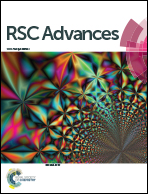Recombinant sFRP4 bound chitosan–alginate composite nanoparticles embedded with silver nanoclusters for Wnt/β-catenin targeting in cancer theranostics†
Abstract
Targeting a specific pathway aberrantly upregulated in cancer cells has shown immense potential in cancer therapy. Although specific signaling pathways have been previously targeted for cancer therapy, the Wnt pathway has been rarely explored in this pursuit. Also an important facet of cancer theranostics is cellular bio-imaging. Taking into consideration these two critical aspects, we herein report the synthesis, bio-imaging and anti-cell proliferative effect of the recombinant secreted frizzled-related protein-4 (sFRP4) bound with silver nanocluster-embedded chitosan–alginate composite nanoparticles. While bacterially expressed and purified recombinant sFRP4 specifically blocked the aberrant Wnt/β-catenin signaling in cancer cells, the remarkable luminescence of the silver nanoclusters enabled imaging, binding, and uptake studies. Both the protein as well as the nanoparticle component of this multifaceted system were responsible for triggering facile cell death; sFRP4 by inhibiting the Wnt signaling, and silver nanoclusters by the activation of reactive oxygen species. Hereby, a co-therapy module was generated that successfully brought about apoptotic cell death. Therefore, the current module has achieved significant benefits for in vitro cancer theranostics.


 Please wait while we load your content...
Please wait while we load your content...